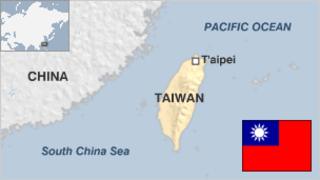Taiwan profile
Taiwan is an island that has for all practical purposes been independent since 1950, but which China regards as a rebel region that must be reunited with the mainland – by force if necessary.
China has claimed sovereignty over Taiwan since the end of the Chinese civil war in 1949, when the defeated Nationalist government fled to the island as the Communists, under Mao Zedong, swept to power.
China insists that nations cannot have official relations with both China and Taiwan, with the result that Taiwan has formal diplomatic ties with only a few countries. The US is Taiwan’s most important friend and protector.
Despite its diplomatic isolation, Taiwan has become one of Asia’s major economic players, and one of the world’s top producers of computer technology.
FACTS
Republic of China (ROC)
Capital: Taipei
Population 23,3 million
Area 36,188 sq km (13,972 sq miles)
Major languages Mandarin Chinese (official), Min Nan Chinese (Taiwanese), Hakka
Major religions Taoism, Buddhism, Christianity
Life expectancy 76,2 years (men), 82,7 years (women)
Currency New Taiwan dollar
LEADER
President: Tsai Ing-wen
Tsai Ing-wen became Taiwan’s first female president when elected in January 2016.
With 56% of the vote, she led her traditionally pro-independence Democratic Progressive Party (DPP) to their biggest ever victory in parliamentary elections.
Ms Tsai’s political message has always revolved around the importance of Taiwanese identity, and she has pledged that democracy will be at the heart of the island’s future relations with China.
By pursuing Taiwanese sovereignty, Ms Tsai runs the risk of antagonising China, reversing eight years of warmer ties under President Ma Ying-jeou of the Beijing-friendly Kuomintang party.
In the 1990s, Ms Tsai negotiated Taiwan’s accession to the World Trade Organization. She joined the DPP in 2004 after working as a non-partisan chairwoman of Taiwan’s Mainland Affairs Council. Four years later she became the youngest person and first woman to lead the party. She lost the presidential election to Ma Ying-jeou in 2012.
A former law professor, she hails from the coastal village of Pingtung in southern Taiwan. Her mixed ethnicity – a Hakka father and Taiwanese mother – has been cited as one of the traits that helped her connect with voters.
MEDIA
The media environment in Taiwan is among the freest in Asia, and extremely competitive.
There are hundreds of newspapers, all privately-owned and reflecting a wide range of views.
Around 88% of Taiwanese are online.
TIMELINE
Some key dates in Taiwan’s history:
1683 – Island comes under administration of China’s Qing dynasty.
1895 – China – defeated in the first Sino-Japanese war – cedes Taiwan to Japan.
1945 – Taiwan reverts to Chinese control after Japanese defeat in Second World War.
1947 – Nationalist troops crush island-wide rioting by Taiwanese disgruntled with official corruption, killing unknown thousands. The event is now known as the 228 Incident.
1949 – Nationalist leader Chiang Kai-shek loses civil war to Mao Zedong’s Communist forces and flees to Taiwan. He rules the island with an iron fist until his death in 1975.
1950s-1960s – Rapid industrial development.
1971 – UN recognises Communist China as sole government of whole country. People’s Republic takes over China’s UN Security Council seat.
1979 – Washington switches diplomatic recognition to Beijing from Taipei. US Congress passes the Taiwan Relations Act promising to help the island defend itself.
1987 – Taiwan lifts almost four decades of martial law and eases ban on travel to China.
2000 – Voters put Democratic Progressive Party in power for first time, ending more than five decades of Nationalist rule.
Source: Read Full Article



